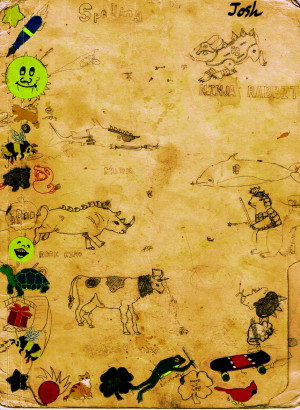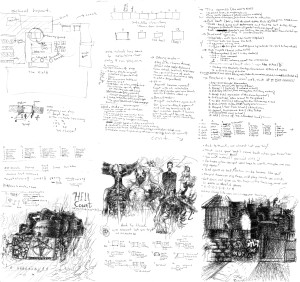Humble Beginnings – Josh Tobey Talk, Part 2
After many weeks, I bring you the second part of the discussion that was recorded with Josh Tobey––Symbolist painter, old friend, and Long John collaborator on the short, “Save the Bones.” In this discussion (attached to the player at the bottom of the post), we mostly talk about Josh’s beginning as an artist in elementary school and how those early inspirations have extended through to today.
It has been said before somewhere on this site (and it’s definitely mentioned in this interview) that Josh and I met in sixth grade. I first learned of his artistic ability through the mandatory folders all the students in this class had to keep and maintain. Ever the rebel, Josh covered his folder in accurate drawings of baby animals copied from a “How to Draw Baby Animals” book and then covered them with ordnance. Somehow, I was able to procure one of these folders and hold onto it for these twenty-three years.
One of the more interesting topics we get into in this discussion is the topic of world-building. I have recently discussed this topic (specifically its strange, toxic co-habitation with storytelling) on the podcast I host with friend, Andrew Asplund, called For All Intents and Purposes, and admitted that––with a few specific exceptions––I am not the strongest world-builder when it comes to my own fiction. I am much more of a character-first kind of creator whereas Josh always dove deep into the mechanics of a fictional world. I’ve always wondered why this kind of split takes place––creators tend to separate into the two camps; it’s not a clean cut, of course, but one side (world-building or storytelling) tends to be favored. Perhaps because I have always felt that I wasn’t really strong in the world-building arena, I have always had a strange admiration for those who are. The first world-builder I met was Josh, and his copious notes and development sketches.
Over the years, Josh and I have started a bunch of creative ventures, from comics to movies to video games. Their development never got too far––I handled characters’ stories and motivations while Josh wove the web of history (from genealogy to geology) for these characters to run around in. Most of our video game ideas were RPGs, styled after those by Squaresoft (pre-Square Enix) and inspired by the video games, anime, and movies we loved at the time. And then there was the handball game.
When Josh and I started hanging out, our friendship was formed in the schoolyard handball court. This isn’t the professional handball played using a racquetball by middle-aged men wearing special gloves at a YMCA. This is children hitting a red rubber ball against a wall of an elementary school. They learn special techniques like pop-ups, sliders, cross-countries, and backcourts. They fall down and hurt themselves. That’s the handball Josh and I bonded over.
Years later, Josh came up with the idea of making a video game based on handball; it was a fantasy-adventure in the guise of a schoolyard sport. He came up with teams and schools that span the continents of the world and the realms of the underworld. He came up with names and special techniques unique to these individual groups. He went further and figured out how the controls would be mapped to a home console controller. That’s world-building on a molecular level.
I recently found all of Josh’s notes about his handball video game and I scanned them in to show you, dear readers, what kind of world-builder Josh is.
Even though these games never saw the light of day, I fell in love with the characters and I fell in love with the worlds to the point that I still carry these ideas and characters and stories with me today, over a decade later (the handball game was pretty much all Josh’s baby, I was just the cheerleader).
With that in mind, I hope you enjoy the discussion and can take more from it with this context. If you want to follow Josh’s work, be sure to like Josh’s official art page on Facebook.
Podcast: Play in new window | Download



Discussion ¬